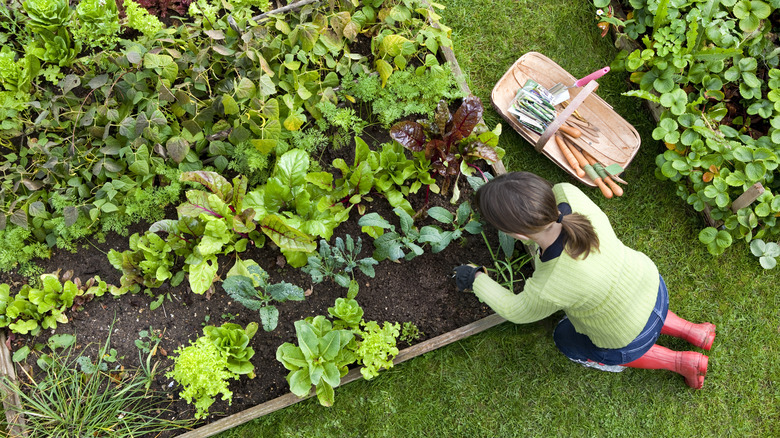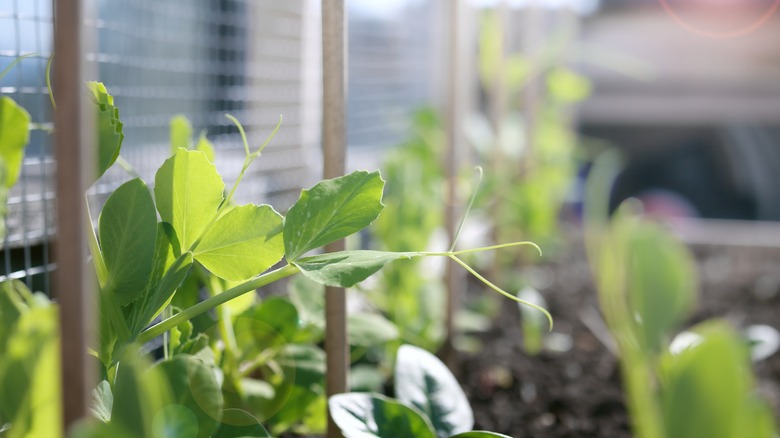This TikTok Tip Keeps Critters Out Of Raised Garden Beds When Growing Garlic
The local critters in your yard are probably no strangers to the veggies you have growing in your garden. One crop in particular that may attract unwanted attention is your savory garlic due to its strong smell and pungent taste. Garlic contains compounds such as allicin, which can act as a natural repellent for some pests, but its odor may also attract other animals curious about potential food sources. Additionally, garlic bulbs provide a nutrient-rich and energy-dense snack for many animals, making them an enticing target for foraging. Some fauna, like rodents, may dig up garlic bulbs to access the tasty treat inside, while others, such as deer or rabbits, may nibble on the green shoots or leaves above ground. Nevertheless, the aromatic properties and nutritional value of garlic make it a tempting and vulnerable target for garden raiders. Fortunately, one account on TikTok seems to have a solution: installing welded wire over your raised garden beds to prevent animals from reaching your garlic bulbs.
In his TikTok video, Earth, Nails, & Tails demonstrates how a few yards of welded wire, some screws, and a drill can be an easy DIY project to protect your garlic, or any vulnerable vegetable, from becoming today's lunch for your animal neighbors. He installs a square welded wire mesh fencing over the top of his raised garden bed with a healthy layer of mulch to protect his garlic bulbs and keep them well hydrated and properly insulated from the elements and animals.
How to install welded wire on raised garden beds
To install your own welded wire over your raised garden bed, you'll need to gather the necessary materials. Begin by acquiring the appropriate size of welded wire mesh, ensuring it's large enough to cover the entire surface area of your garden bed with some extra for overlap. Additionally, gather wire cutters, stakes or screws, a hammer or drill, and gloves for safety. First, measure the dimensions of your raised garden bed to determine the amount of wire mesh needed. Cut it to size, making sure it fits securely over the bed with a few inches of overlap on all sides. Next, carefully lay the wire mesh over the garden bed, ensuring it's flat and covers the entire surface evenly.
Once the mesh is in position, secure it firmly in place using stakes or screws along the edges and at intervals across the bed. Hammer the stakes or drill the screws into the ground securely to prevent any gaps that critters could exploit to access the garden bed. Ensure that the wire mesh is taut and securely fastened to prevent animals from pushing it aside or chewing through it. Finally, trim any excess wire protruding from the edges to create a neat and tidy appearance while also minimizing the risk of injury. Regularly inspect the wire mesh for any signs of damage or loosening, repairing or reinforcing it as needed to maintain its effectiveness in protecting your garden from uninvited diners.
Drawbacks to this solution
While welded wire can be an effective solution for protecting raised garden beds from critters, there are several drawbacks to consider before implementing this method. One significant downside is the potential for increased difficulty in accessing the garden bed for planting, weeding, and harvesting. Since welded wire creates a physical barrier around the bed, it can be cumbersome to lift or remove when performing these tasks. This inconvenience may deter some gardeners from maintaining their garden beds regularly.
Additionally, welded wire can detract from the cosmetic appeal of the garden, especially if not installed neatly or if left in place year-round. The metal mesh may create an unsightly barrier that clashes with the surrounding landscape or detracts from the aesthetic beauty of the plants. This issue is particularly relevant for gardeners who prioritize the visual aspect of their outdoor spaces and seek to create an inviting environment.
Finally, using welded wire to protect raised garden beds will incur additional costs, both initially for purchasing the materials and tools needed for installation and maintenance, as well as over time for repairs and replacements. The upfront investment in high-quality welded wire and sturdy stakes or screws can be substantial, particularly for larger garden areas or multiple beds. Additionally, ongoing expenses may arise for repairing damaged mesh or replacing worn-out components over time. These costs should be carefully considered when evaluating the feasibility of using welded wire as a critter deterrent for raised garden beds.

